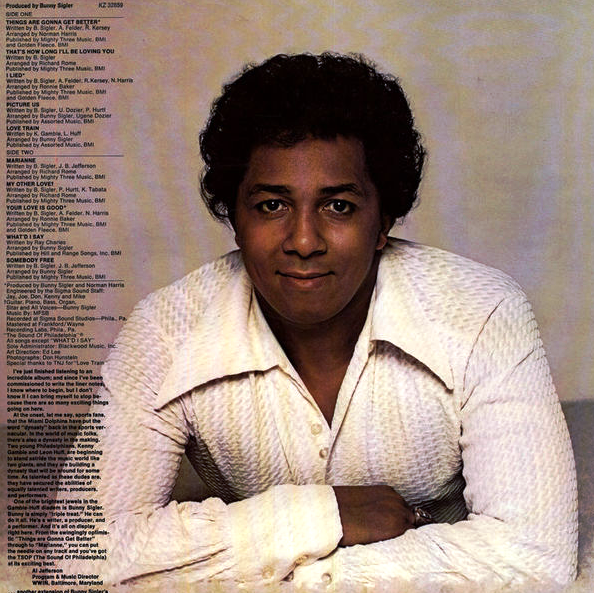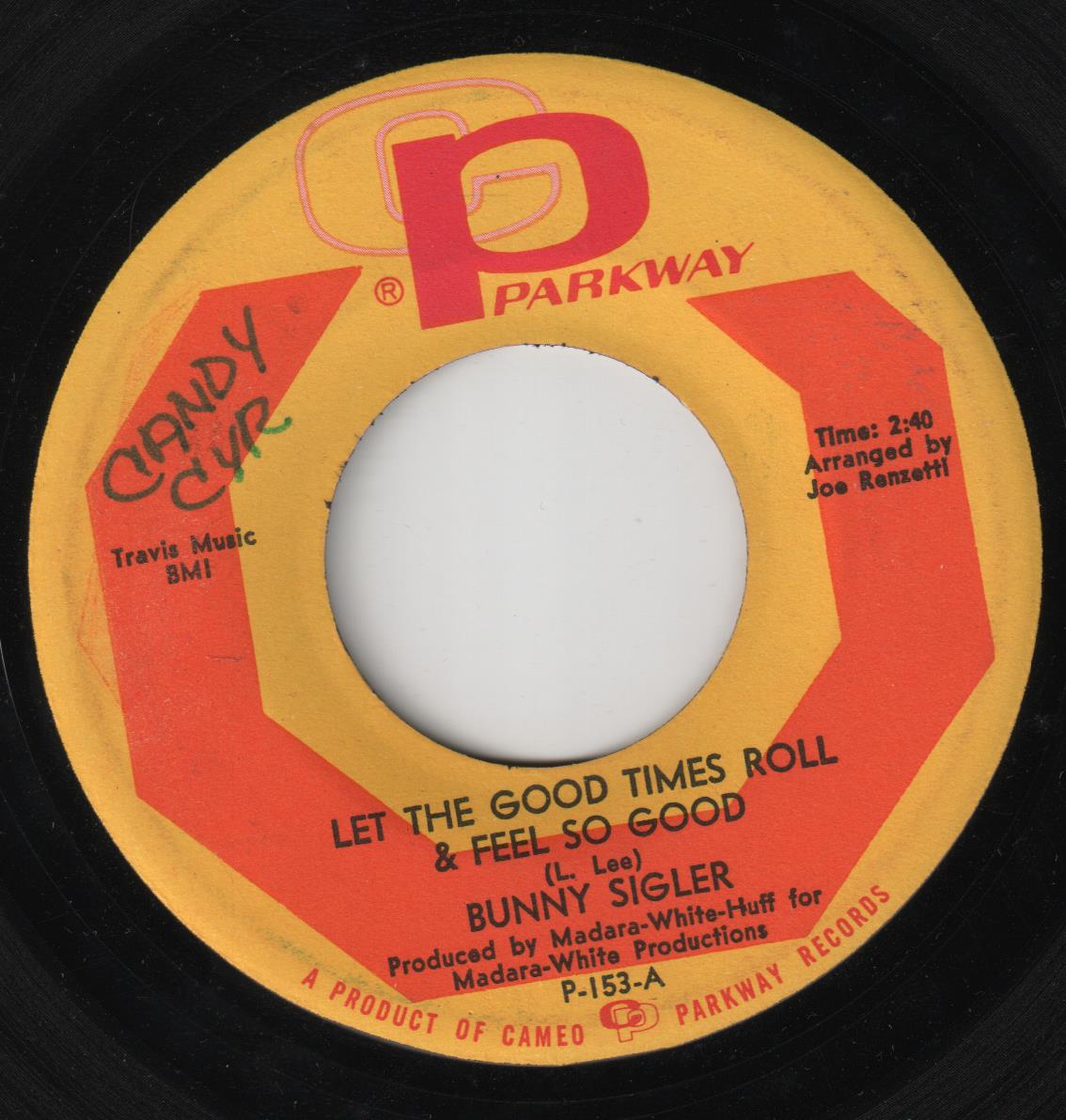BUNNY SIGLER

Walter "Bunny" Sigler was a performer, songwriter and producer who was instrumental in the creation of the "Philly Soul" sound of the 1970s.
He was born Walter Sigler in Philadelphia on March 27, 1941. As an infant, he had a fully grown front tooth. His mother nicknamed him “Bunny” as she thought it made him look like one.
As a child, Sigler performed gospel numbers at the Helping Hand Rescue Mission and at various churches. As a teen-ager, he sang at the Roman Emanuel Baptist Church and in local doo-wop groups like the Opals (which also included his brother, James Sigler). Despite his musical pursuits, what the young man really wanted was to play basketball professionally; but a leg injury squelched that goal. Sigler then threw himself into music with a vengeance. He made his first recordings in 1959 for the V-Tone label in Philadelphia.
Following a performance at the Ambassador Hotel in Atlantic City, Sigler came to the attention of songwriter/producer Leon Huff. He suggested to producers John Medara and David White that they check out Sigler’s performance. Medara and White were impressed enough to sign Sigler and produce an album on him for Cameo/Parkway Records. Its first single, “Girl, Don’t Make Me Wait,” garnered some airplay but did not chart. The follow-up, “Let the Good Times Roll & Feel So Good,” was a medley of two 1950s hits by the Rhythm & Blues duo, Shirley & Lee. It became Sigler’s first hit single, reaching #20 R&B and #22 pop in the summer of 1967. It was, however, his only major hit for Cameo/Parkway as the company went out of business a few months later.
Sigler began to hang out in the hallway of Gamble & Huff Productions. Kenny Gamble suggested that he go into a room with staff songwriter Ugene Dozier to see if they could come up with anything. Sigler had not thought about being a songwriter but took a stab at it. He would eventually publish hundreds of songs.
By 1970, Gamble & Huff Productions had become Philadelphia International Records. Sigler got his big break when “Sunshine,” which he co-wrote with Phil Hurtt, came out as the flip side of the O’Jays’ massive hit, “Back Stabbers.” The identically titled album included two more Sigler/Hurtt numbers, “When the World Is at Peace” and “Who Am I.” The next O’Jays LP, Ship Ahoy, featured Sigler’s first solo writing effort, “You Got Your Hooks in Me.” Sigler’s songs, production, piano playing and back-up vocals would turn up on dozens of Philadelphia International recordings by acts like Billy Paul, Harold Melvin & The Blue Notes, and Lou Rawls.
In 1972, Gamble and Huff gave Sigler the go-ahead to record himself as a performer. The following year, he grazed the national charts with a remake of the twelve-year-old Bobby Lewis hit, “Tossin’ and Turnin’.” In 1974, PIR released two LPs on Sigler, That’s How Long I’ll Be Loving You and Keep Smilin’. The former included a gospel-flavored re-do of the O’Jays #1 hit, “Love Train.”
With Philly Soul burning up the charts and airwaves, Sigler worked with a number of acts as a songwriter and/or producer. They included the Whispers, Ecstasy Passion & Pain, and Carl Carlton (“Everlasting Love,” 1974). He produced acts on Curtis Mayfield’s Curtom label, including Mayfield himself, and recorded an LP of duets with Barbara Mason (“Yes, I’m Ready,” 1965). In 1976, Sigler got the band Instant Funk a deal with Gamble & Huff’s TSOP label. He cut an album on them, Get Down on the Philly Jump, which produced a pair of songs that became popular in discotheques: the title cut and “It Ain’t Reggae (But It Sho Is Funky).”
In 1978, Sigler switched to Norman Harris’ Goldmind label and brought Instant Funk with him. His first Goldmind release, “Let Me Party With You (Party, Party, Party),” became Sigler’s first top ten R&B single. And the identically titled album was huge in the discos. When Goldmind folded, its artist roster was moved to Salsoul, which had distributed the label. There, Lerry Levan’s remix of Sigler’s year-old production of Instant Funk’s “I Got My Mind Made Up (You Can Get It)” became a #1 Soul hit and reached #20 on the pop charts. For good measure, both the single and the album Instant Funk were certified gold. In the wake of that success, both Sigler and Instant Funk worked with other Salsoul acts—including Loleatta Holloway, Double Exposure, and First Choice.
Salsoul ceased operations in the early ‘80s, though Bunny Sigler continued to write and produce. He scored with the #1 R&B hit, “Do You Get Enough Love” by Shirley Jones (1986), and with Patti LaBelle’s million-seller, “Somebody Loves You Baby (You Know Who It Is)” (1991). Sigler also collaborated on tracks by Phyllis Hyman, Stephanie Mills, PIR veterans Lou Rawls and Billy Paul, and the band PLEX (among others).
On March 29, 2007, Sigler performed the 23rd Psalm at the ceremony awarding the Congressional Gold Medal to the Tuskegee Airmen at the U.S. Capitol. He also co-wrote “The Ruler’s Back,” the opening track on Jay-Z’s album, The Blueprint.
Walter “Bunny” Sigler, 76, died of a heart attack on October 6, 2017.
Charted singles:
“Let the Good Times Roll & Feel So Good” (1967) R&B #20, Pop #22
“Lovey Dovey & You’re So Fine” (1967) Pop #86
“Tossin’ and Turnin’” (1973) R&B #38, Pop #97
“Love Train (Part 1)” (1974) R&B #28
“Keep Smilin’” (1974) R&B #46
“My Music” (1976) R&B #98
“Let Me Party With You (Party, Party, Party)” (1977) R&B #8, Pop #43
“I Got What You Need” (1978) R&B #42
“Only You” (with Loleatta Holloway, 1978) R&B #11, Pop #87
“Don’t Even Try (Give It Up)” (1978) R&B #94
“By the Way You Dance (I Knew It Was You)” (1979) R&B #37

